Who says size doesn’t matter! Bruce Corfe checks out a mega-model in sunny Western Australia
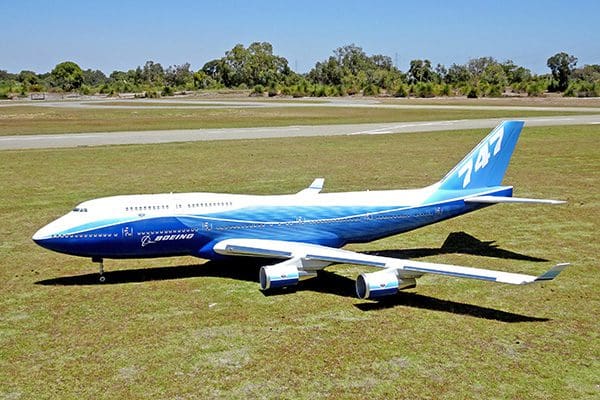
Whoever said ‘size doesn’t matter’ had obviously never heard of Perth modeller, Andrew Herzfeld. Andrew has created, from scratch, not one but two enormous turbine-powered scale model airliners; the one featured here is his awe-inspiring four-engine 747-400 ‘Queen of the Sky’. Andrew claims it is the largest flying model Jumbo Jet (dramatic pause…) in the World!
Andrew is a leading light in the modelling scene in Perth, Western Australia, in particular because of his involvement with jets. I’d seen his previous giant-scale jetliner, his A300-200 twin, at model shows in Perth. I recently asked Andrew for some background information.
Enjoy more RCM&E Magazine reading every month.
Click here to subscribe & save.
He worked in the cray-fishing industry after leaving school before the end of Year 10 and then began training as a commercial pilot. He achieved a commercial pilot twin IFR rating, unfortunately directly before the 1989 Australian airline pilots’ strike, which crippled the industry. He then worked as a skipper, operating ferries at Perth and Mandurah (80km south of Perth) and then a fishing charter boat in Broome (in the Kimberley region, over 2200km north) and as an earthmoving machine owner/operator, also in Broome.
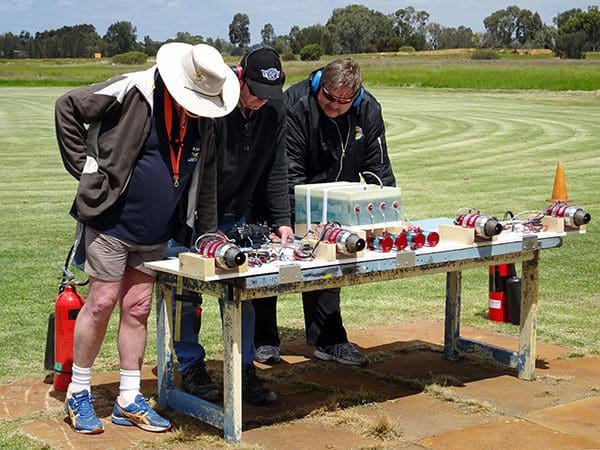
Building model aircraft has been a passion of his for over 40 years. He became interested in models as a young child living in a two-storey house with a large back lawn overlooking Perth Airport, which saw him launching many paper aircraft and small balsa models off the verandah in his younger years. His first R/C model was an Aeroflyte ‘Brolga’, a 2m thermal glider, which he launched off the coastal dunes at Quinn’s Rocks, north of Perth.
A family move to Jurien Bay (200+ km north of Perth, on the Indian Ocean coast – apologies for the geography lesson!) was where Andrew got together with a group of fishermen who flew at the local airfield. The favourite aircraft back then was a Funkey ‘Skyleader’ pattern ship with an OS 60 FSR and a tuned pipe.
Andrew’s first introduction to jets was with a Falcon 120 and since then many models have rolled out of Hertzy’s Hangar, including sports jets, his giant scale A330 and, of course, the Jumbo. The current jet scene in Perth includes ‘WestJet’, which Andrew has been involved with for many years, both as events officer and Club President. WestJet has a membership of around 30. They fly at local fields and have Civil Aviation Safety Authority (C.A.S.A.) approval to operate at two full-sized airfields in Western Australia, at Wagin and Wongan Hills, both of which are several hours’ drive from Perth.
His reason for deciding to tackle the 747 was that he’s always been fascinated with the sheer size of the Jumbo and so he decided to set out to bring something unique to the jet scene in Perth.
CONSTRUCTION
The plans were drawn from a scaled-down version of the full-size aircraft’s plans. Profiles were drawn to enable cutting of the shapes from polystyrene foam. The foam was hand cut from plywood profile templates using a hot wire. In total there were 28 separate core sections, which were then joined together to complete the core. The core was then sheeted with 2mm balsa, filled, sanded smooth and then layered with light fibreglass cloth and epoxy resin. Carbon fibre was used to strengthen the core where required.
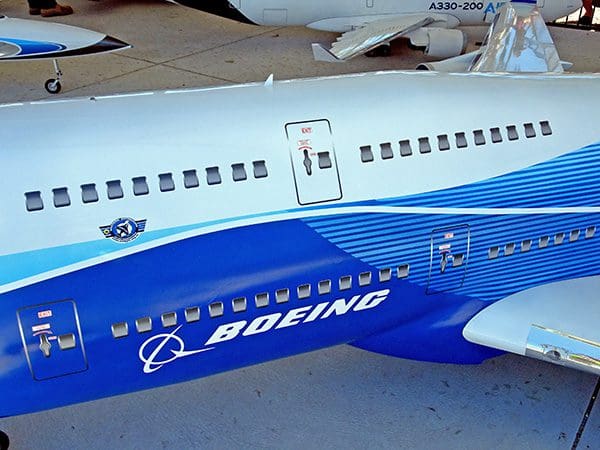
The engines used are four ATJ 140 SVs, with onboard computer systems and a combined thrust of 56 kgs. Each engine is mounted on a carbon fibre mount joined to the two spars that run the full length of the wing. 20 litres of Jet A1 fuel give a flight time of 10 minutes. All the electronics, fuel pumps and FADECs (Full Authority Digital Engine Controls) are located close to each engine in the wing.
The electronics installation is complex. In total there are 74 electronic components, including 22 servos, five electric retract units, two retract controllers, brakes and navigation lights, with nine 6000mAh batteries, four of each of the turbine components, plus a great many adaptors, converters and switches. The retract system comprises eight servo driven gear doors and five electric retract units. It requires the use of two programmable control units and the gear system in the JR 28X transmitter, all working together to enable the systems to work. The control system utilises the JR Xbus system.
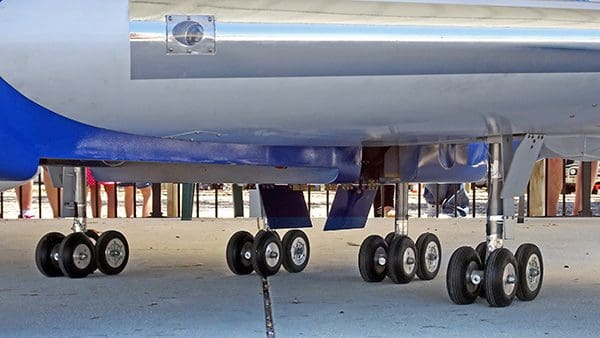
The engine nacelles were made by hand-cutting foam to the required shape using three sections. A ply profile was placed on the ends and the centre was removed using a hot wire. Once happy with the shape it was layered up with glass and epoxy resin. Engine mounts were made using a foam core, plus carbon and epoxy, with 10mm ply layered in to form the mounts. All control surfaces were constructed using the same method of balsa and glass over foam. All were hand-cut using a hot wire. Control horns were hand-cut from 2mm fibreglass sheet.
The undercarriage was turned up from aluminium. There was a lot of mathematics involved here to be sure that the legs were the correct length, to ensure that the model sat at the correct angle on the ground and gave enough ground clearance for the engine nacelles. Each leg is individually sprung.
PAINTING
Andrew says:
“Once the fuselage, fin and three wing sections were sheeted with 2mm balsa they were covered with light cloth and epoxy resin. The process involved using a peel ply to create a smooth finish.
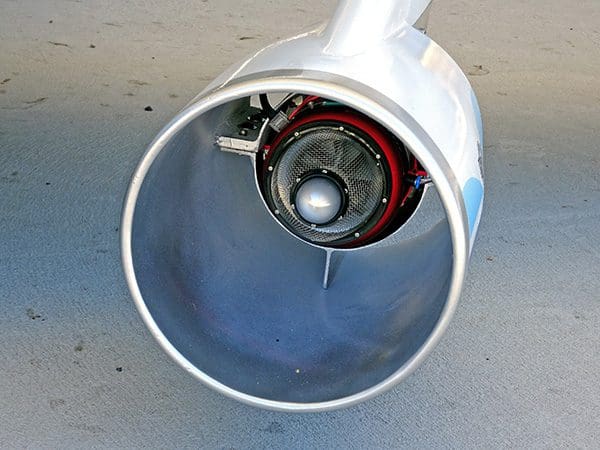
Painting was an experience in itself. I chose the original Boeing promotional colours, as my favourite colour is blue and I didn’t want to represent any particular airline’s scheme. I obtained all the right gear and a lot of advice from a friend who works for a local paint supplier (Boris Dropulicat, S+S Industries, Perth). Not having completed a spray-painting job before, the advice I was given was very valuable. The process took a solid 32 hours and was completed in one sitting, all done in a makeshift spray booth in my backyard shed. As a first timer spray painter the end result was pretty close to what I had envisaged.
The decals were a masterpiece in themselves and were created by great friends in the hobby, Lori and Rod O’Niel. They were applied using a laser to ensure that they were straight”.
FINALLY THERE!
Andrew’s son, Nelson helped during the build and was his biggest ‘quality controller’ throughout! Weighing in at 65kgs the model is 5.6m in length, has a wingspan of 5.2m and is constructed from polystyrene foam, balsa wood and fibreglass. The model is transported in a home-built custom-made trailer. The wings are removable to allow for ease of transport.
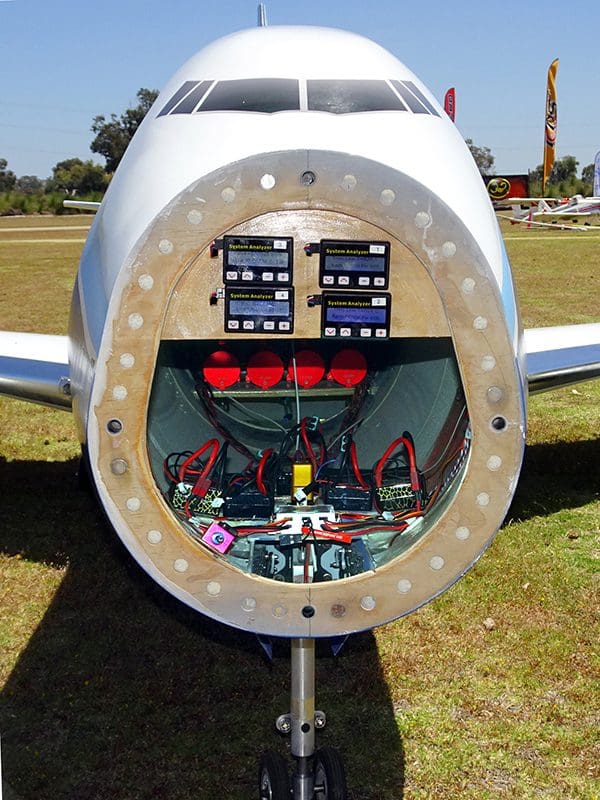
The certification process involved many cups of coffee during the build process with local Giant Model inspector Ken Greaves. In line with the Model Aircraft Association of Australia procedures the model was inspected at every stage throughout the build.
The location of Wagin Airfield was chosen as the best place to commit to a maiden voyage and after obtaining the necessary CASA approvals, two attempts were made (foiled by bad weather) before the world’s largest RC Jumbo Jet finally flew on the 19th May 2018.
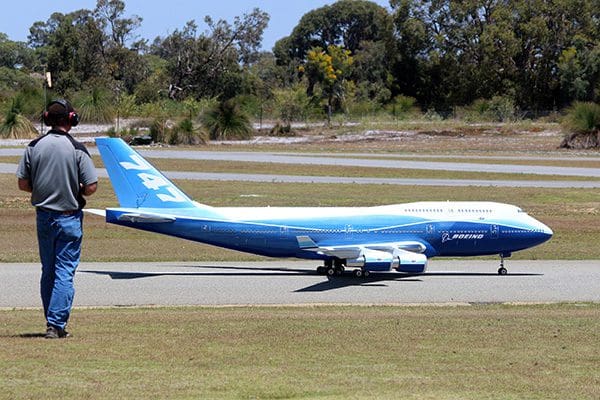
After two years of construction and much red tape the model finally took to the skies over Wagin Airfield. Although every calculation and a rigorous inspection process had taken place, the first flight of the model was a nerve-wracking experience and one which could have seen the aircraft end in a huge fireball on the runway! It was with huge relief and loud cheers from the many onlookers that the aircraft took off perfectly and completed a seven-minute flight before it was time to complete the most important part of any flight, the landing. Having had only seven minutes to get the feel of the aircraft, Andrew’s instinct took over and he landed the aircraft safely. The 747 has since completed many flights and, having been certified to the requirements of the MAAA, is now allowed to fly for public display.
>IN ACTION
Back to Andrew:
“After successfully building my four metre A330 twin turbine (100n) airliner and subsequently having enjoyed many enjoyable and challenging flights, I acquired the plans to build the giant scale Jumbo Jet. Many weeks were spent simply looking at the plans and making decisions on how things were to be done, checking numbers, how to go about building the aircraft and making it into a flying replica of the Queen of the Sky.
The first block of polystyrene foam was purchased in January 2016 and the hot wire cutting began once the profiles were made, from computer generated images. Over a week later I was able to assemble the cut pieces and begin to see the aircraft taking shape. The nose section was hand-carved from outlines off the plan.
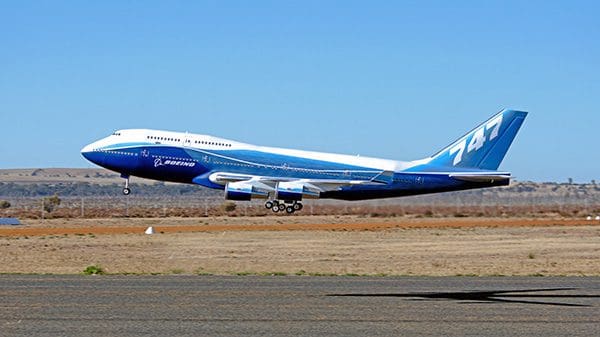
All the parts for the aircraft were hand cut. One of the many challenges of building this aircraft was the undercarriage, to enable the five legs to operate in sequence along with the eight gear doors.
A dream became a reality when I was offered the opportunity to take the model to Perth Airport and place it alongside a real Qantas 747 400. The 747 400 ‘Queen of the Sky’ has always held my fascination, and, on many occasions, I have been overawed by the sheer size of the aircraft and how it is possible for 360 tonnes of metal to be able to fly.
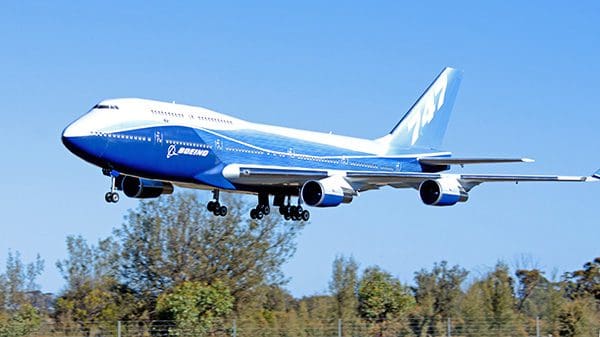
To be able to place my model alongside the real deal and have the opportunity to show my model to the crew of the Qantas jet was an amazing experience. To add to the experience, I was fortunate enough to be allowed to view the cockpit and sit in the captain’s seat. The crew were fascinated by my aircraft, congratulated me on my work and were very curious to know the technical details of the model.
Having lived through traumatic events throughout my life – serious illness and other issues – having a passion for model aircraft has helped me along the way to be not just a survivor, but a thriver. I am the president of WestJet, which is W.A.’s model jet aircraft association. We fly at the Western Australian Model Aircraft State Centre, (WAMASC) at Whiteman Park, Perth, the Kalamunda Aero Modellers Society, (KAMS), south of Perth, and Wagin Airfield, where we have secured a five-year C.A.S.A. approval to fly R/C models. Wagin is currently the only airfield at which the 747 can be flown because of the size of the aircraft.
Flying? After the nerves of the first few flights, flying the giant-sized model is much the same as any other model. However, it does use a lot more of the sky and muscles are a little more tense knowing that there is a whole lot more that can go wrong. Four miniature turbines, 74 electronic components, 54 amps-worth of batteries and 20 litres of Jet A1, all encased in a polystyrene foam tube and all relying on a single 0.032mm copper wire – what could possibly go wrong?!
Many nerves were tested as the model built up speed before the undercarriage finally let go of the ground with what turned out to be a perfect take off and climb out. One click of left aileron trim was all that was required to see the model settle into some very smooth circuits around the skies over Wagin. After several circuits testing stall characteristics and flap settings a missed approach was aborted, before a second approach saw the model land safely and in one piece, to the relief of all those involved!
Despite all of the above, the model has now flown successfully on 14 occasions (as of June 2020) and is always a great crowd pleaser”.
TAILPIECE
Your scribe first got wind of the 747 when I saw Andrew and his helpers testing four large turbine engines and ancillary equipment on a static bench at a flying site (KAMS) near Perth. The noise and drama on power-up was astonishing. I am not ashamed to say that as the four engines reached full power, I watched from behind a nearby car!
I then saw the newly completed 747 at Perth’s magnificent WAMASC flying site at Whiteman Park, where it dwarfed the pit area! Andrew taxied the then as yet un-flown and un-certified model for the benefit of the large audience at the model show, and accompanied by young son Nelson, used the P.A. to explain technical details to an appreciative crowd.
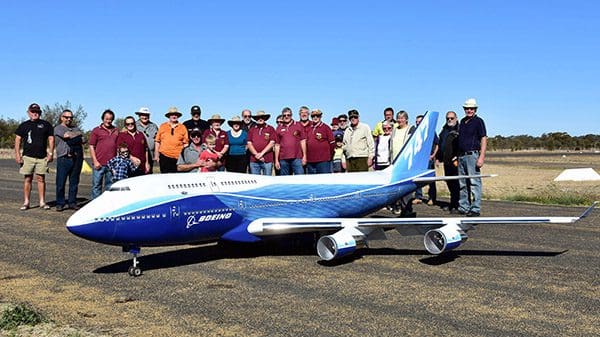
The successful certification flights and all subsequent ones to date have taken place at Wagin Airfield, which has become WestJet’s newly adopted home. I am grateful to Alex Genovese for his photos of the first flights. In the air the only word to describe the model is ‘magnificent’. The realism is amazing. I urge readers to look at videos and other images of the model (see links) to get a better idea of the scale of Andrew’s achievement.
LINKS
WestJet: www.westjet.org.au
Facebook: search ‘Westjet’
WAMASC: www.wamasc.com.au
KAMS: kamsrc.com.au




